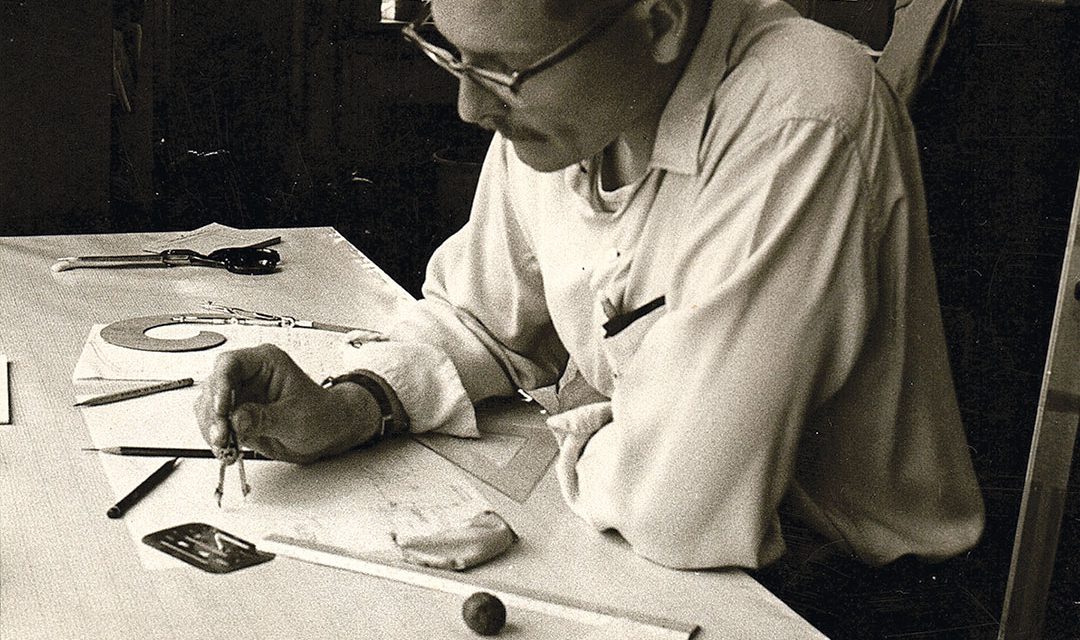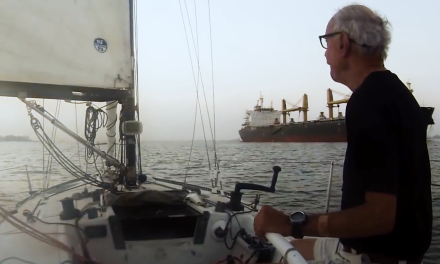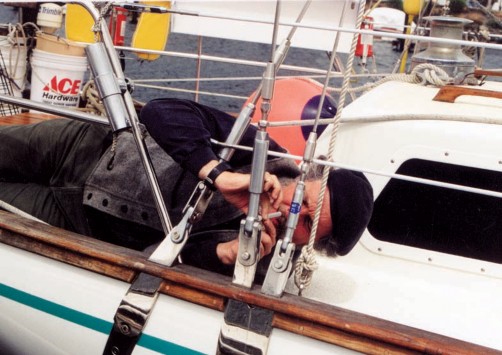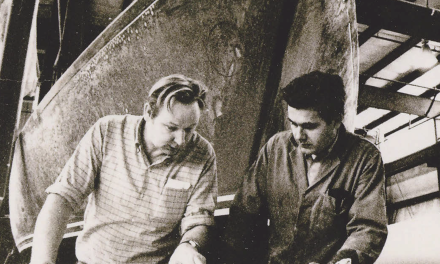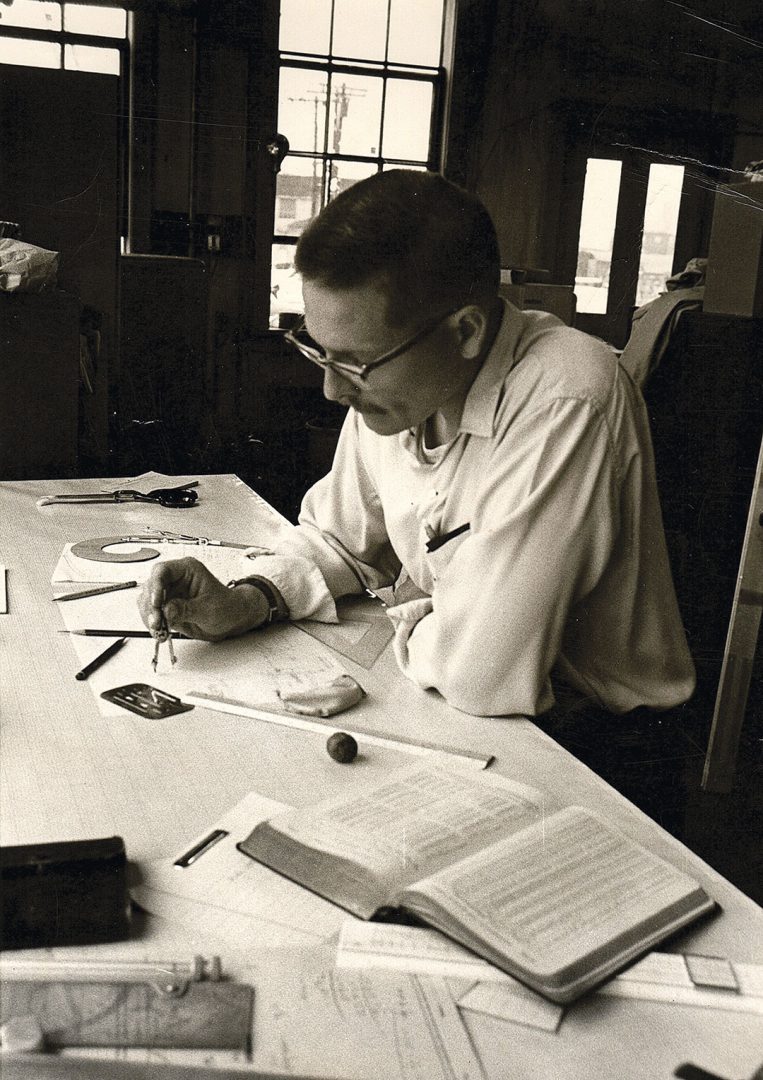
Yacht designer Ted Brewer gazes back over a storied career.
Ted and Betty Brewer’s living room is warm and inviting. Two harpoons hang on teak-colored walls, and a model boxcar sits on the shelf alongside other artifacts marking a life well-lived. A picture window overlooks a baseball diamond across a quiet street in Agassiz, British Columbia. With its neat buildings and carefully trimmed yards, the town feels bricked with charm and mortared with apple pie. But just outside the window, above the baseball diamond, the craggy, glaciated peak of Mount Cheam towers, a reminder of the wild Coast Mountains and North Cascades ranges that embrace the community.
“I’ve never been a sit-down draftsman. I’ve always been standing up at the drafting board,” says Edward “Ted” Brewer, the world-renown yacht designer who worked on two America’s Cup contenders and designed 260 boats including yachts built by Aloha, Morgan, Nimble, Union, and Whitby.
“For many years it was standing up at the drafting board with a cigarette,” says Betty.
“Yeah, too many years with a cigarette,” Ted agrees, leaning back in a sage-green armchair with extra foam padding. “No more cigarettes.”
At 87, Ted no longer designs or smokes, but he tells stories with his whole being, arms thrown up in amazement, voice soaring high with incredulity, mouth crinkling with infectious laughter. A mischievous twinkle in his eyes reveals a certain boyish quality that belies his grey hair. On his left forearm, a weathered tattoo takes him back to his youth, roaming the Navy docks in Hamilton, Ontario, learning to sail from his father’s veteran friends.
“By the time I was 15, I was proficient at rigging, rowing, and sailing, and I was allowed free run of the Navy’s 14-foot dinghies and 26-foot whaleboats. I could go down to the Navy base in Hamilton and sign out a 27-foot sailboat on my own account. My girlfriend, her girlfriends, and my buddies would all be there. We’d get the boat rigged and ready and out we would go.”
When he was about 15, Ted and a friend bought their first boat.
“We coughed up 55 dollars for Quest, a 16-foot ship’s gig that someone had put a long wood fin on and an overly heavy, gaffy rig.” A year of scraping, painting, and replacing rotted planks, and Quest was ready for her maiden voyage. After ballasting her with 400 pounds of sandbags, they cast off into afternoon squalls. They were soon knocked down, and panic rose as water came over the lee hull. The two boys managed to fling the sandbags over the side and eventually right her. Upon being towed in, a photographer appeared on the scene, and much to Ted’s chagrin a photo of their woeful yacht made the paper the next day.
It wasn’t long after that he got the tattoo: an anchor with Quest stenciled beneath it.
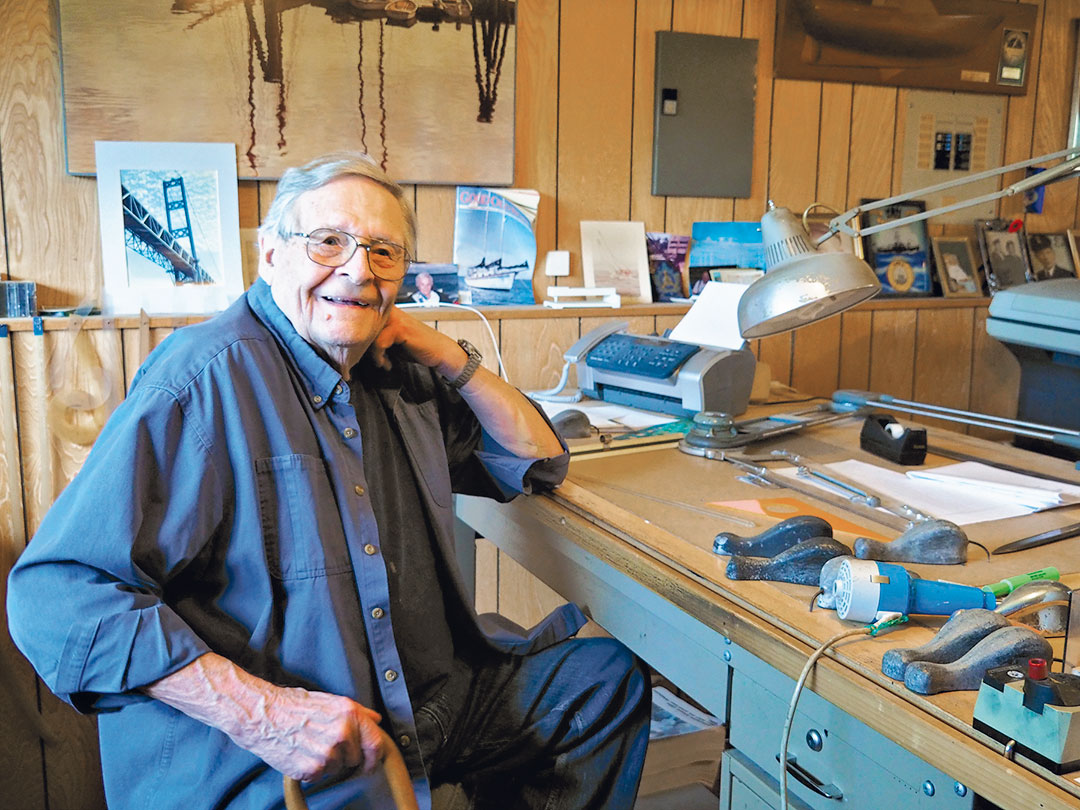
Downstairs in Ted’s studio, half-models and photos of some of his hundreds of designs cover the wood-panelled walls. Two drafting boards hold metal weights or “whales” (aka ducks), a handful of pens and pencils, articulating table lamps, cardboard blueprint tubes. These are the tools of a traditionalist; Ted has always preferred drawing by hand to using CAD software.
Even as a child, he liked to draw. He would doodle Navy boats in the margins of his school papers where, despite being the youngest in his class, he earned top grades, at least until high school, when boredom set in.
“I really goofed off…I quit school to get a job as a Class 4 electrician at the steel company in Hamilton.”
During one night shift, Ted read a military recruiting advertisement in Liberty magazine. The next morning, he went to the armory and signed up.
“I didn’t get home until almost 10 a.m. When mum met me at the door she asked if I had to work overtime again. I said, ‘No, I just joined the Army,’ and I caught her before she hit the floor!”
Ted survived the grueling Army boot camps, and by 1957 he’d made lieutenant. But he remained restless, and one day, his company commander finally suggested that he pursue his passion for boating. “He knew I loved boats. I resigned my commission and got a job in Toronto as a yacht broker with George Cuthbertson.”
Cuthbertson, who would go on to become the first “C” in C&C Yachts, at the time was building Inishfree, a 54-foot wooden ocean racing yawl. Not long after joining the firm, Ted asked if he could accompany Dick Telford, the yacht brokerage firm’s boatbuilder, to see Inishfree under construction. When he saw the yard and spoke with the builders, Ted was struck with yearning.
“I thought, ‘Oh god, this is what I want. I want to design boats and build boats.’ ’’ Encouraged by Telford, Ted enrolled in a yacht design course at Westlawn Institute of Marine Technology. He’d almost completed it when he heard that Alfred Edward “Bill” Luders Jr. in Stamford, Connecticut, was looking for a design assistant.
“With Dick’s blessing, I applied for the job.”
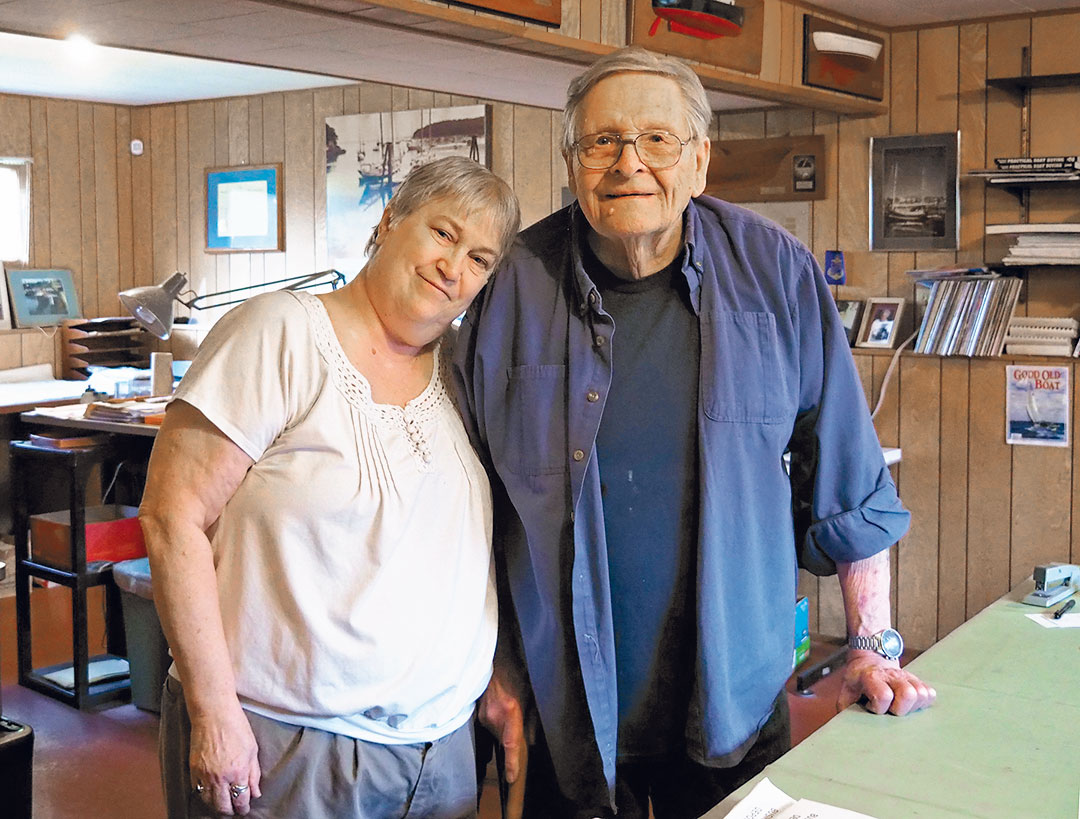
“He doesn’t stand for very long,” Betty says, gently ushering Ted over to an office chair. Seated, Ted reaches for the computer mouse, one of few visible concessions to modern technology. Above the desk is a black-and-white photo of Bill Luders’ 40-foot Storm flying a spinnaker. Tucked into a corner of the frame is a photo of Luders himself, in a pullover and collared shirt.
In 1960, at the age of 27, Ted started working as Luders’ assistant, basically a second-in-command in the shipyard. He’d visit each department daily to see what was happening, problem-solve, and then head for the drafting room, where Luders would give him sketches to turn into a working drawing. At the end of the workday, Luders and Ted would sit in the office, smoking, and mull over designs and construction work. Often Ted would ask for Luders’ advice on his own designs. “He didn’t look at me as competition,” Ted says.
While at Luders, Ted worked on two America’s Cup boats. Weatherly, a Phil Rhodes design, which they modified, went on to win the 1962 regatta, and Luders earned the commission to design, and build a 1964 contender, American Eagle. Though American Eagle was initially the “bird to beat,” winning 20 out of 21 races in the June and July trials, by the end of summer Constellation, designed by Olin Stephens, had pulled ahead and won the right to defend the 19th America’s Cup.
By 1968, the shipyard business was foundering, and Luders closed Luders Marine Construction Co., 60 years after his father had founded it. Ted and Luders remained close until Luders’ death in 1999.
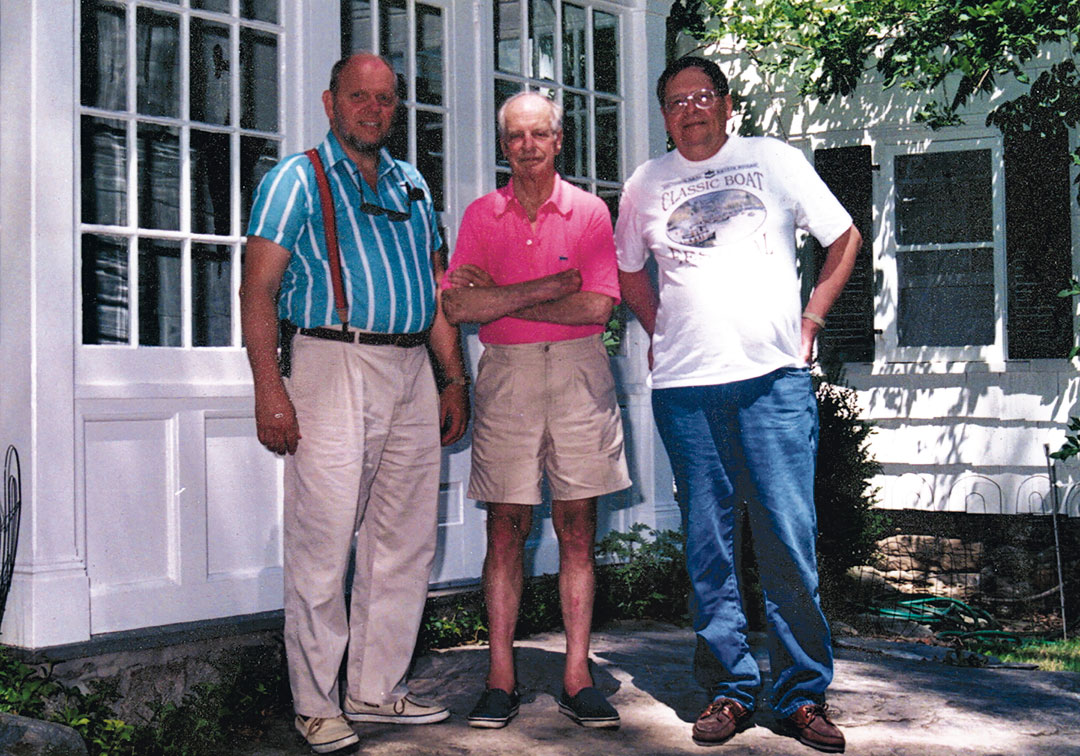
“Bill Luders was my boss, my teacher, and my great friend,” Ted says. “He was like a second father to me. I truly loved the man.”
After Luders closed the yard in 1968, Ted moved to Brooklin, Maine, to hang out his shingle. He bought an old hotel from the 1870s, “a weird place. It had eight or nine bedrooms, and only one bathroom. My first office was in the hotel dining room.”
There, he developed a design for a client who sailed on Lake Champlain and wanted a boat that would go well to weather. The boat was eventually named Black Velvet, and at the boat show in Annapolis, Kurt Hansen of Whitby Boat Works saw a photo of it and said, “I want a boat just like that.”
But as Ted began working with Whitby Boat Works, he discovered Hansen had some ideas of his own. Though Black Velvet was a fin keel, Hansen insisted on a full keel. “I wanted to at least cut it away and make the rudder separate. But no, it had to be full keel.”
At a time when full keels were the gold standard for cruisers, Ted often found himself attempting to sway owners to incorporate a fin keel’s windward sailing advantages.
“I felt the ideal was a fin keel with a skeg hung rudder behind it…If a client wanted a full keel boat, I’d cut away as much of the keel as I could…When he complained, I’d have to add a bit back.” This “Brewer Bite” would become one of Ted’s signature design features.
The Whitby 42 became an enormously popular design, selling over 230 hulls, and according to Ted, “was what established me as a production boat builder, designer.”
In 1976, Morgan Yachts approached Ted to work with Jack Corey, head of Morgan’s design staff, on a 36- to 38-foot fast cruiser. Ted recalls taking the Morgan 382 on its first sea trial. What started as a great day for a sail quickly descended into inky black skies and a lightning storm, with strikes as close as 50 yards from the boat. Though frightful, the boat emerged unscathed, perhaps the beginning of a lucky streak that would see 400 Morgan 382s built between 1977 and 1981.
Ted rests a forearm on the desk and gazes up. Centered above the desk is a large-format color photograph of a ketch flying two rainbow spinnakers over turquoise water. This was Mystic, which he designed for Marvyn Carton, who became a lifelong best friend. Built of aluminum, Mystic was launched and sailed through the Great Lakes to Europe. Ted sailed the boat with Carton in a Transpac that started slow and became a wild ride.
“We’d be going down waves doing 17 knots. Almost everybody on board was seasick. We roared through for about six or seven days of this storm. All the time Marv’s listening to the radio, and we’re hearing about crews that are out with sickness, broken this and broken that, and boats turning back. But we were on a big custom cruiser.” Not only did they finish second in class, Carton celebrated by serving the crew a 55-gallon-drum of Mai Tais and flying all their wives and sweethearts to Hawaii to join the party.
One day in 1988, Ted, living in Anacortes at the time, was driving home when he spotted a man on a BMW motorcycle.
“I owned a BMW, brand new, and so I followed him home, my big black dog on the seat beside me, and pulled into his driveway. He came out very suspicious.” Once Ted had introduced himself, the two men bonded over motorcycles, and pretty soon, the fellow introduced Ted to his daughter, Betty.
“She had just had a divorce, and I was winding up a rather disastrous marriage, so I asked her for a date to go sailing. I had rather a fancy little yawl, one that I’d designed, a Nimble 30,” Ted says. Betty, who at that point had sworn off men, was taken with Ted.
“I was definitely swept off my feet,” she says. After marrying in 1988, Ted and Betty eventually moved to Gabriola Island in 1999, where Ted designed custom yachts, sold plans, and wrote for magazines, including Good Old Boat. From 1998 to 2003, Ted was a contributing editor at Good Old Boat. He wrote humorous stories in “Fireside chats with Ted Brewer,” divulged lessons on cruising etiquette, and shared his love and knowledge of boat design.
Though he often wrote highly technical articles, Ted liked to have fun with his topics. In the July/August 1999 issue, in an article called “Brewer by the Numbers,” Ted discussed different ratios and terms used by yacht designers. Amid LODs, LOAs, LWLs, CBs, and CEs, Ted introduced a new ratio, the Comfort Ratio (CR), a formula that indicates the speed of the upward/downward motion of a boat in waves and swell. The lower the ratio, the more uncomfortable the ride.
“People were coming up with all of these sail area displacement ratios and this and that ratio. I thought, well there’s one ratio that nobody’s ever thought of, a comfort ratio. I’ll work one out,” he says. “So, I diddled around and came up with this crazy comfort ratio, and it was a joke and I published it, and it took off like a rocket. It does have a basis in fact, but I thought it was a joke.” The CR ratio remains in use to this day.
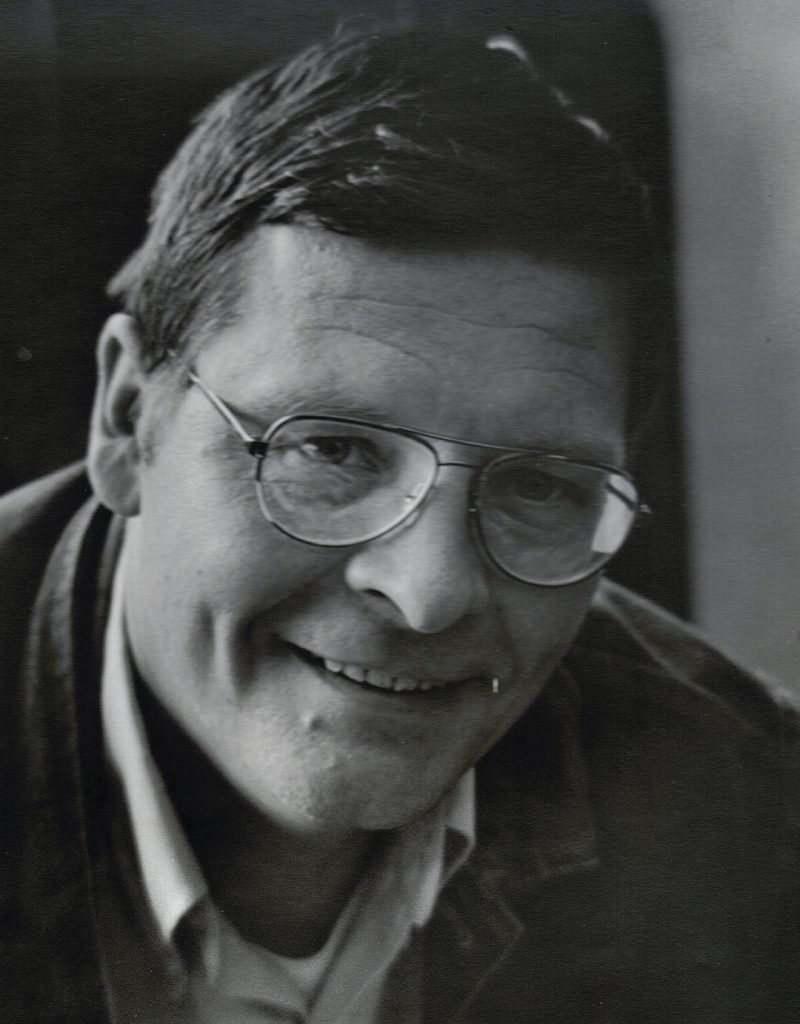
In addition to writing articles, Ted also authored three books, Understanding Boat Design, Cruising Yacht Design, and Ted Brewer Explains Sailboat Design.
These days, Ted no longer draws, but he still sells boat design plans to boatbuilders around the world at TedBrewer.com.
“His babies are everywhere,” says Betty. “When we were sailing, he would pick up the binoculars and he would look and look and say, ‘That’s one of my babies!’ ”
Some of Ted’s boats have also retired. No longer racing, Weatherly and American Eagle are in the America’s Cup Charters fleet in Newport, Rhode Island, where sailors can experience the golden age of America’s Cup racing. Other boats have had less dignified endings. Ted points to a model boat in a glass case and says, “I’ll tell you where that is right now. That’s 200 feet underwater off the coast of Machias, Maine, with a cargo of marijuana.”
Some people find time heavy on their hands when they retire, but Ted has always pursued interests including folk music, American Civil War books, and model trains. Nor are these always half-measure hobbies; at one point he had a couple hundred feet of railroad in the backyard, and to this day he sells plans for model railroad buildings and bridges online at BrewerPlans.com.
Recently, he has become an avid stock investor. He wakes up at 5 a.m, and with a coffee in hand, he checks the stock markets before going downstairs to his computer to “make any buys, sells, and trims” and answer email inquiries about his boat designs.
Retiring is in some ways like crossing a finish line, a time to reflect on achievements and legacies. Ted’s career has been extraordinary, and it’s clear that he relished every tack, jibe, and sail change. But most important to him, it seems, are the people who mentored and influenced him: George Cuthbertson, Bill Luders, Marvyn Carton, and Dick Telford among others. You need only look around his studio, where seemingly every square inch of wall space is dedicated to a boat or a photo of a loved one.
As Ted works at his computer, cane propped against one knee, Storm and Bill Luders watch down from their frame.
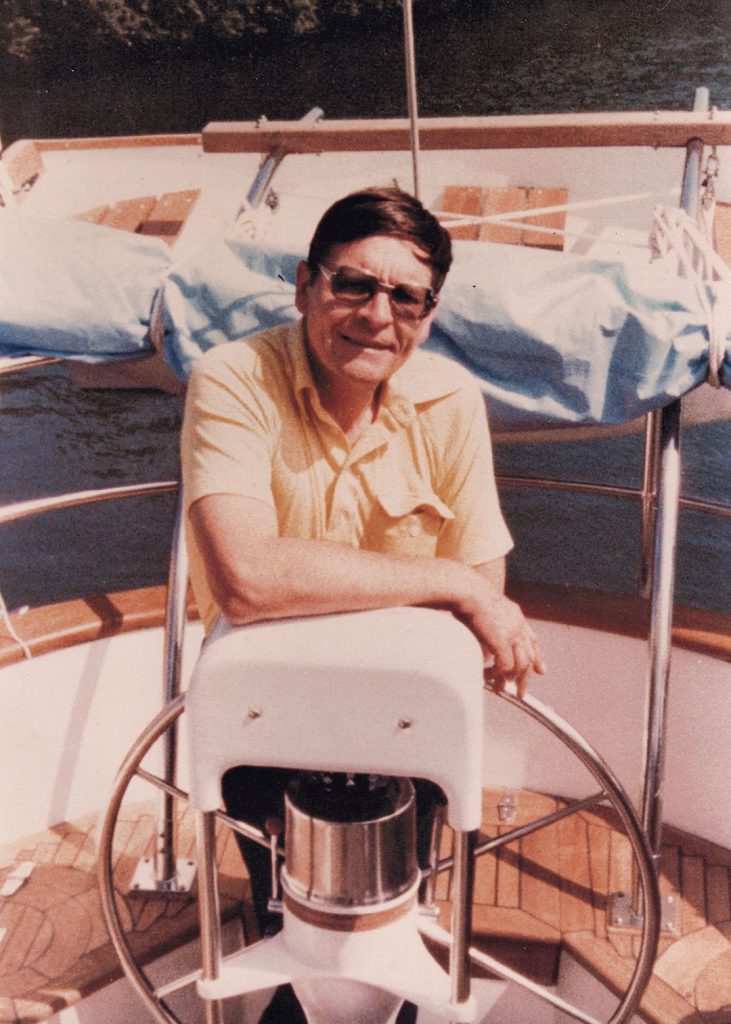
“The last race we ever sailed together was in 1967,” Ted says. “Bill had been at the helm two hours and said, ‘Boys I need a rest, I’m just getting weary here, somebody take over.’ Everybody volunteered and he said, ‘No, we need the best at the helm, come on, Ted.’ I drove her to within a half mile of the finish line and I said, ‘Here, Bill, take over now.’ He took her across the finish line. We won. We were not only first in our class, we were first overall. The boat was that good.”

